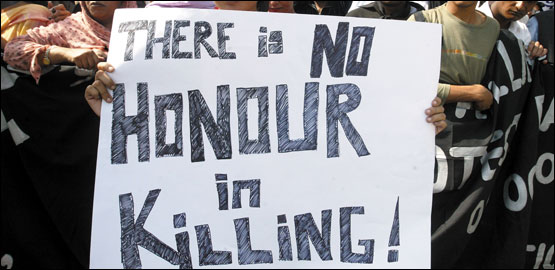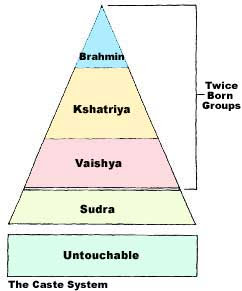 Recently, there has been a spate of killings in the country and this has led the government to decide what laws should be put in place to stop this heinous crime. Also whether the Hindu Marriage Act should be reformed or not is being debated. The latest case of caste honour killing was reported from New Friends Colony, where a couple was murdered by the father of the girl, Vimla (20), and a guard named Robin, after they found 28 yr old Hari from Jalandhar and Vimla in a compromising position in an under-construction building. So what is the definition of honour killing and what leads families to commit this heinous crime so that they can protect their family honour? Is this practice prevalent only in India or is it prevalent in other parts of the world also? What are the misconceptions regarding honour killing and what are the solutions to stop this crime from spreading? These are the questions that this article seeks to find an answer to.
Recently, there has been a spate of killings in the country and this has led the government to decide what laws should be put in place to stop this heinous crime. Also whether the Hindu Marriage Act should be reformed or not is being debated. The latest case of caste honour killing was reported from New Friends Colony, where a couple was murdered by the father of the girl, Vimla (20), and a guard named Robin, after they found 28 yr old Hari from Jalandhar and Vimla in a compromising position in an under-construction building. So what is the definition of honour killing and what leads families to commit this heinous crime so that they can protect their family honour? Is this practice prevalent only in India or is it prevalent in other parts of the world also? What are the misconceptions regarding honour killing and what are the solutions to stop this crime from spreading? These are the questions that this article seeks to find an answer to.
Honour killing is defined as a death that is awarded to a woman of the family for marrying against the parent’s wishes, having extramarital and premarital relationships, marrying within the same gotra or outside one’s caste or marrying a cousin from a different caste. Honour killing is different from the dowry deaths that are also a very common practice in India as, in the case of dowry deaths, the perpetrators of that action claim that they have not been given enough material rewards for accepting the woman into the family. In that case there is a lot of harassment from the in-laws and more times than one, it has been noted that the wife commits suicide rather than being killed by the in-laws, though it has to be said that she has been mentally killed, if not physically. We have had a tradition of honour killing. This tradition was first viewed in its most horrible form during the Partition of the country in between the years 1947 and 1950 when many women were forcefully killed so that family honour could be preserved. During the Partition, there were a lot of forced marriages which were causing women from India to marry men from Pakistan and vice-versa. And then there was a search to hunt down these women who were forced to marry a person from another country and another religion and when they returned ‘home’ they were killed so that the family honor could be preserved and they were not declared social outcastes from their region. At that time, the influence of religion and social control was much greater and hence there were at least a couple of honour killings a day, if not more. The partition years can be seen to be the beginning of the tradition of honour killing on a large scale. It’s worth mentioning here that Honor Killing is not specifically related to India only. This is a practice that continues to be prevailing in North and South America, Africa, Turkey and many other countries. But the thing that has to be kept in mind is that the number of incidents relating to this crime is very low and there is a very strict punishment for committing this crime in other countries.
Now, there are various reasons why people or family members decide to kill the daughter in the name of preserving their family honour. The most obvious reason for this practice to continue in India, albeit, at a much faster and almost daily basis, is because of the fact that the caste system continues to be at its rigid best and also because people from the rural areas refuse to change their attitude to marriage. According to them, if any daughter dares to disobey her parents on the issue of marriage and decides to marry a man of her wishes but from another gotra or outside her caste, it would bring disrepute to the family honour and hence they decide to give the ultimate sentence, that is death, to the daughter. Now as has become the norm, the son-in-law is killed as well. Sociologists believe that the reason why honour killings continue to take place is because of the continued rigidity of the caste system. Hence the fear of losing their caste status through which they gain many benefits makes them commit this heinous crime. The other reason why honour killings are taking place is because the mentality of people has not changed and they just cannot accept that marriages can take place in the same gotra or outside one’s caste. The root of the cause for the increase in the number of honour killings is because the formal governance has not been able to reach the rural areas and as a result. Thus, this practices continues though it should have been removed by now.
There are various misconceptions regarding the practice of honor killing. The first misconception about honor killing is that this is a practice that is limited to the rural areas. The truth is that it is spread over such a large geographical area that we cannot isolate honor killings to rural areas only, though one has to admit that majority of the killings take place in the rural areas. But it has also been seen recently that even the metropolitan cities like Delhi and Tamil Nadu are not safe from this crime because 5 honor killings were reported from Delhi and in Tamil Nadu; a daughter and son in law were killed due to marriage into the same gotra. So it can be seen clearly that honor killing is not isolated to rural areas but also to urban areas and as already pointed out, it has a very wide geographical spread. The second misconception regarding honor killing is that it has religious roots. Even if a woman commits adultery, there have to be four male witnesses with good behavior and reputation to validate the charge. Furthermore only the State can carry out judicial punishments, but never an individual vigilante. So, we can clearly see that there is no religious backing or religious roots for this heinous crime.
 Recently, there has been a spate of killings in the country and this has led the government to decide what laws should be put in place to stop this heinous crime. Also whether the Hindu Marriage Act should be reformed or not is being debated. The latest case of
Recently, there has been a spate of killings in the country and this has led the government to decide what laws should be put in place to stop this heinous crime. Also whether the Hindu Marriage Act should be reformed or not is being debated. The latest case of 
